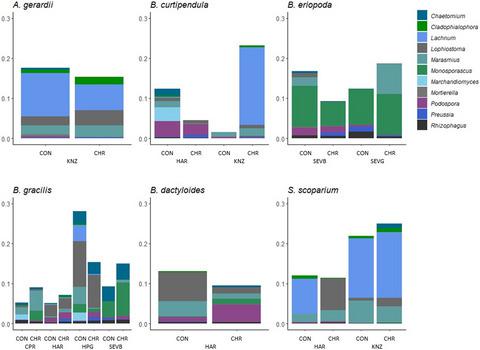Our official English website, www.x-mol.net, welcomes your feedback! (Note: you will need to create a separate account there.)
Experimental drought re‐ordered assemblages of root‐associated fungi across North American grasslands
Journal of Ecology ( IF 5.5 ) Pub Date : 2020-10-08 , DOI: 10.1111/1365-2745.13505 Devon Lagueux 1 , Ari Jumpponen 2 , Andrea Porras‐Alfaro 3, 4 , Jose Herrera 5 , Y. Anny Chung 3, 6 , Lauren E. Baur 3 , Melinda D. Smith 7 , Alan K. Knapp 7 , Scott L. Collins 3 , Jennifer A. Rudgers 3
中文翻译:

实验性干旱使北美草原根相关真菌重新组合
更新日期:2020-10-08
Journal of Ecology ( IF 5.5 ) Pub Date : 2020-10-08 , DOI: 10.1111/1365-2745.13505 Devon Lagueux 1 , Ari Jumpponen 2 , Andrea Porras‐Alfaro 3, 4 , Jose Herrera 5 , Y. Anny Chung 3, 6 , Lauren E. Baur 3 , Melinda D. Smith 7 , Alan K. Knapp 7 , Scott L. Collins 3 , Jennifer A. Rudgers 3
Affiliation

|
- Plant‐associated fungi can ameliorate abiotic stress in their hosts, and changes in these fungal communities can alter plant productivity, species interactions, community structure and ecosystem processes.
- We investigated the response of root‐associated fungi to experimental drought (66% reduction in growing season precipitation) across six North American grassland ecosystem types to determine how extreme drought alters root‐associated fungi, and understand what abiotic factors influence root fungal community composition across grassland ecosystems.
- Next generation sequencing of the fungal ITS2 region demonstrated that drought primarily re‐ordered fungal species' relative abundances within host plant species, with different fungal responses depending on host identity. Grass species that declined more under drought trended toward less community re‐ordering of root fungi than species less sensitive to drought. Host identity and grassland ecosystem type defined the magnitude of drought effects on community composition, diversity and root colonization, and the most important factor affecting fungal composition was plant species identity.
- Fungal diversity was less responsive to drought than fungal composition. Across ecosystems, latitude and soil pH were better predictors of fungal diversity than experimental drought. Drought significantly reduced fungal diversity and evenness only in sideoats grama Bouteloua curtipendula and reduced root colonization only in blue grama B. gracilis.
- Our results illustrate that predicting the effects of drought on root‐associated fungi will require attention to host plant identity and ecosystem type. By comparing our findings against soil microbe responses in the same experiment, we propose the hypothesis that fungi in plant roots are less sensitive to drought than fungi inhabiting soils. Our study highlights the importance of studying community‐level re‐ordering of fungal composition for understanding plant responses to climate change.
中文翻译:

实验性干旱使北美草原根相关真菌重新组合
- 与植物相关的真菌可以减轻宿主体内的非生物胁迫,这些真菌群落的变化可以改变植物的生产力,物种相互作用,群落结构和生态系统过程。
- 我们调查了北美6种草地生态系统类型的根系真菌对实验干旱的反应(生长季节降水减少66%),以确定极端干旱如何改变根系真菌,并了解哪些非生物因素影响根系真菌的组成。草原生态系统。
- 真菌ITS2区域的下一代测序表明,干旱主要重新排列了宿主植物物种内真菌物种的相对丰度,其真菌响应取决于宿主的身份。与干旱较不敏感的草种相比,干旱下草木种类减少更多的趋势是根真菌的群落重新排序减少。寄主身份和草原生态系统类型决定了干旱对群落组成,多样性和根定殖的影响程度,影响真菌组成的最重要因素是植物物种的身份。
- 真菌多样性对干旱的反应不如真菌组成。在整个生态系统中,纬度和土壤pH值比实验干旱更好地预测了真菌的多样性。干旱仅在侧纹盲目Bouteloua curtipendula中显着降低了真菌的多样性和均匀性,仅在蓝纹盲目B. gracilis中减少了根的定植。
- 我们的结果表明,预测干旱对根系真菌的影响将需要注意寄主植物的身份和生态系统类型。通过在同一实验中将我们的发现与土壤微生物反应进行比较,我们提出了一个假设,即植物根部的真菌对干旱的敏感性低于土壤中的真菌。我们的研究强调了研究社区一级真菌组成的重排对于理解植物对气候变化的反应的重要性。



























 京公网安备 11010802027423号
京公网安备 11010802027423号